Outside the Darkness
Critical text for the show of Peter Richards, Intuitive Actions, Common Attributes and Isolated Incidents. Millennium Court Arts Centre, Portadown, September – November 2014.
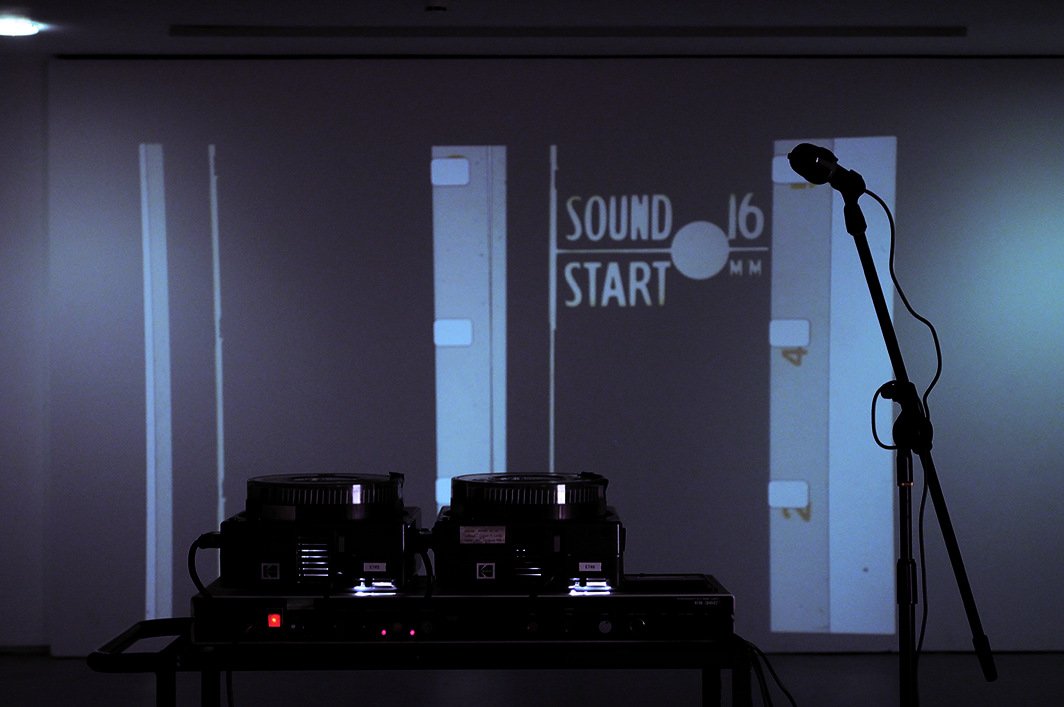
Peter Richards, preparation for and anticipation of, 2014. A 12 minute action with an Electrosonic ES3601 Presentation Unit, two Kodak carousel projectors, a section of 16mm leader, and a 12 minute endless audio cassette. Dimensions variable. 1978
The more open, or ambiguous, the experience offered, the more the viewer is forced to depend upon his [sic] own perceptions. Lucy Lippard [1]
A young performer, in front of an audience and a TV crew who are filming him with three cameras, tries to do as little as possible over a span of 5 minutes, measured by the hands of a clock hung on a wall next to the artist himself. This single action is accompanied by a few others: sitting next to a table; walking; talking; smoking; drinking. The five minutes seem endless and there is a certain suspense in the air, tinged with an awkwardness in the faces of both the artist and the audience.
The recording of these simple movements, of this reduced and suspended time that is pending a more concrete action, is then put on TV monitors. It is a guide for the artist to repeat the entire sequence again, this time provoking irony and curiosity in everyone, given the evident impossibility of repeating the actions exactly.
This is Untitled: Live Video Interaction. Exercise 1, the 1996 performance of Peter Richards (Cardiff, 1970) created for the 2e Recontre International d’art Performance in Quebec. That year, 1996, was an important one for Richards. It was the year of his first solo show at the Context Gallery in Derry, and it was when he became a co-director of the artist-run Catalyst Art, Belfast. A video transmitted by webcast is dedicated to the Canadian performance, in which the various performances are shown and commented on in the studio, with the addition of a then-innovative ingredient: the possibility to comment via live chat.
The VHS of the broadcast, in black and white, is in the centre of the main hall of the Millennium Court Art Centre for Peter Richards’ solo show, Intuitive Actions, Common Attributes and Isolated Incidents. A nearly prehistoric monitor and an old tape recorder are made available to the visitor, who can rewind and fast-forward the tape at will.
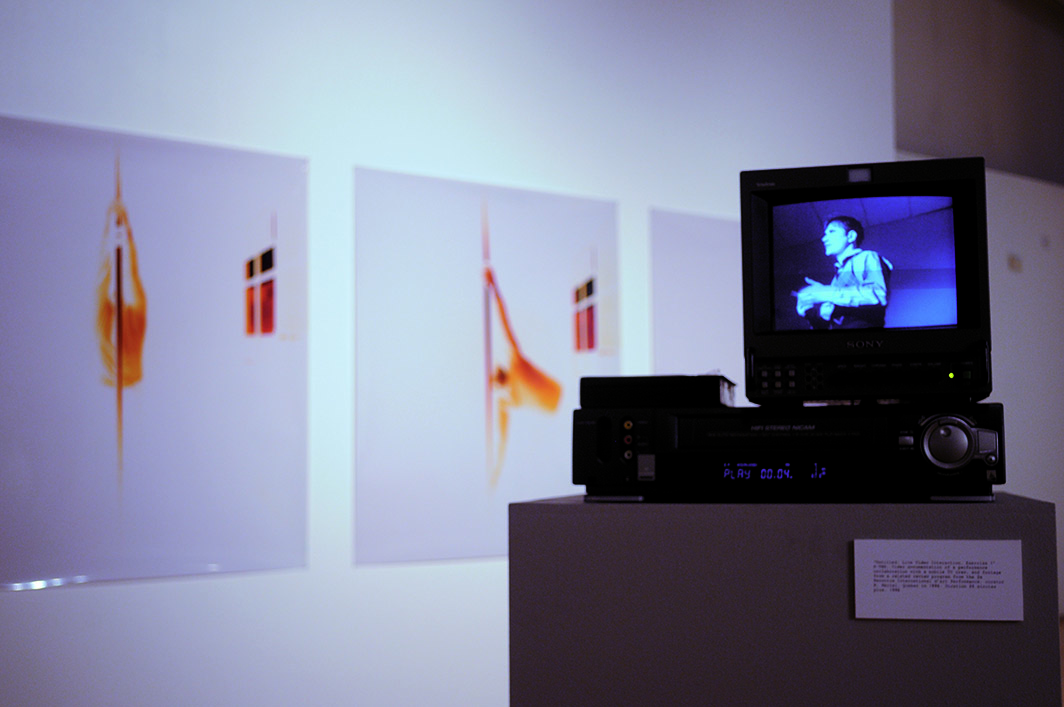
Peter Richards, Untitled: Live Video Interaction. Exercise 1, 1996, S-VHS, Video documentation of a performance collaboration with a mobile TV crew from the 2e Recontre International d’art Performance, curator R. Martel, Quebec in 1996. Duration 25 minutes plus.
It is therefore a personal and individual viewing of the work that immediately refers to the caption that stands out in red on white in the wall drawing at the beginning of the exhibition path, “… not (a) beginning…,” where the artist quotes from Samuel Beckett’s Endgame: “Mean Something! You and I! Mean Something!” The interpretation the artist asks of the viewer seems pretty clear. To give meaning, together, us with him: to the works; to the entire exhibition; to the experience itself.
The wall drawing immediately opens up another issue behind each work on display, and also behind Richards’ entire journey.
The source of these three imperatives is a direct quotation that may not be immediately clear. It can only be discovered by entering into another level of consciousness of the work, which goes beyond the first experiential veil of perception. We can already grasp something through the reading of a strange caption, very different from those written on the paper accompanying the exhibition. Does every work have two captions? Almost. Are they both true? Yes. Which questions do they pose? To try to understand. To take some paths, and discard others.
And it is here that a series of actions is set off, like a treasure hunt. First of all, checking whether all the works are accompanied by a double caption. We discover that three of them have only one. These are, by no coincidence, works completed before 2014: the video documentation mentioned above; another performance video (also on VHS and presented on a small and “subjective” television display) from 1995 in the second room, Untitled: table & chair exercise 9.1; and the consolation piece – since it is familiar to those who know Richards’ latest works – The Significance of Vitalism in Red from 2013, also in the second room.
All of the nine remaining works on display are accompanied by long explanations and strange dates, some even before the birth of the artist. What is hidden behind this can be intuited. It is not even necessary to discover it completely. By now, in fact, a chasm has been opened. It is not a precipice, but a depth of interpretation that can be only partially grasped.
What is certainly perceivable, even at first glance, is the incredible volume of references, both formal and in content, both between the works on display and between those works and Richards’ other activities. The artist partly restores curiosity by giving the visitor the possibility of finding treasures during the hunt: some books are provided, complete with bookmarks on the pages related to a citation used for a work, as in the case of Endgame, referenced above.
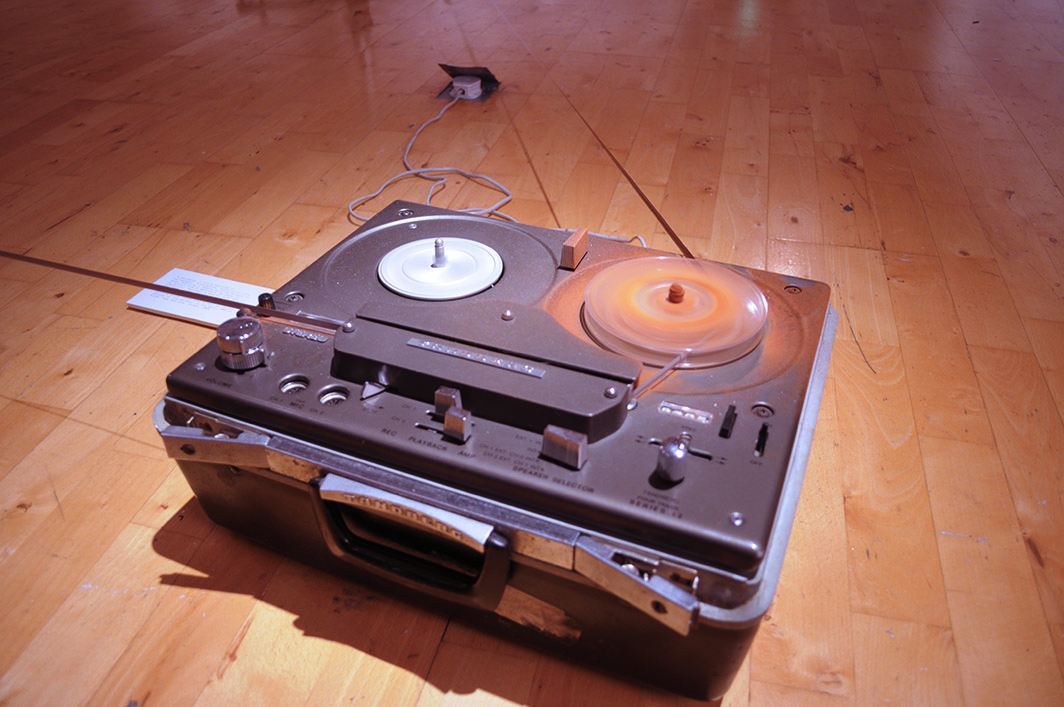
Peter Richards, A perimeter, a futile exercise in cartography, 2014. A sculptural installation with audio featuring a reading by Elisa Nocente of an extract from H. Marcuse’s An essay on Liberation. Recorded on quarter inch reel-to-reel tape, looped, and played back across a system of reel-to-reel players. Accompanied by a repair kit mounted on a plinth, comprising a splicing block, (last used to edit an omnibus edition of the Archers in the early 1980’s) blade, tape and note.
Besides Beckett, there is Herbert Marcuse, An Essay of Liberation, first published in 1969, given purposefully to the caption of the work A perimeter, a futile exercise in cartography. It is an audio recording of an extract from Marcuse’s book, read by Elisa Nocente, recorded on a reel-to-reel tape played in loop on three vintage tape recorders placed on the ground and accompanied by substitute material (including instructions) in case of malfunction. The tape gives sculptural body to the work by forming a large and delicate triangle on the ground and also gives substance to time. Nocente’s voice becomes ever less audible with each day that passes, but the consumption of the tape creates a dust, the ashes of time. And the ashes refer to another work, Star Dust: Prototype Death Chair, the completion of a work through a close collaboration with other artists, curators, professors, writers, etc., it recalls a well-established practice for Richards.
21 Variations, dated (in the wall caption) to 1970, the year of Richards’ birth, is exemplary in this sense. There are twenty-one variations on one single theme, or rather, twenty-one written responses to a question posed to twenty-one different people invited by Kim McAleese, a curator from Belfast. Their responses, written in pen, are printed next to their photograph, taken with a technique that is very dear to Richards: a pinhole photograph in which the aperture is left open for the duration of the writing action, from when the subject picks up the pen to when he or she places it on the table. The question was asked only after the subjects entered the artist’s studio, the set of this series. The question was as simple as it was uncomfortable – being existential: “What do you think you are doing here, now?” The responses vary; two are ‘blank’ (Unattended and Apologies) while one portrait is completely black, by mistake.
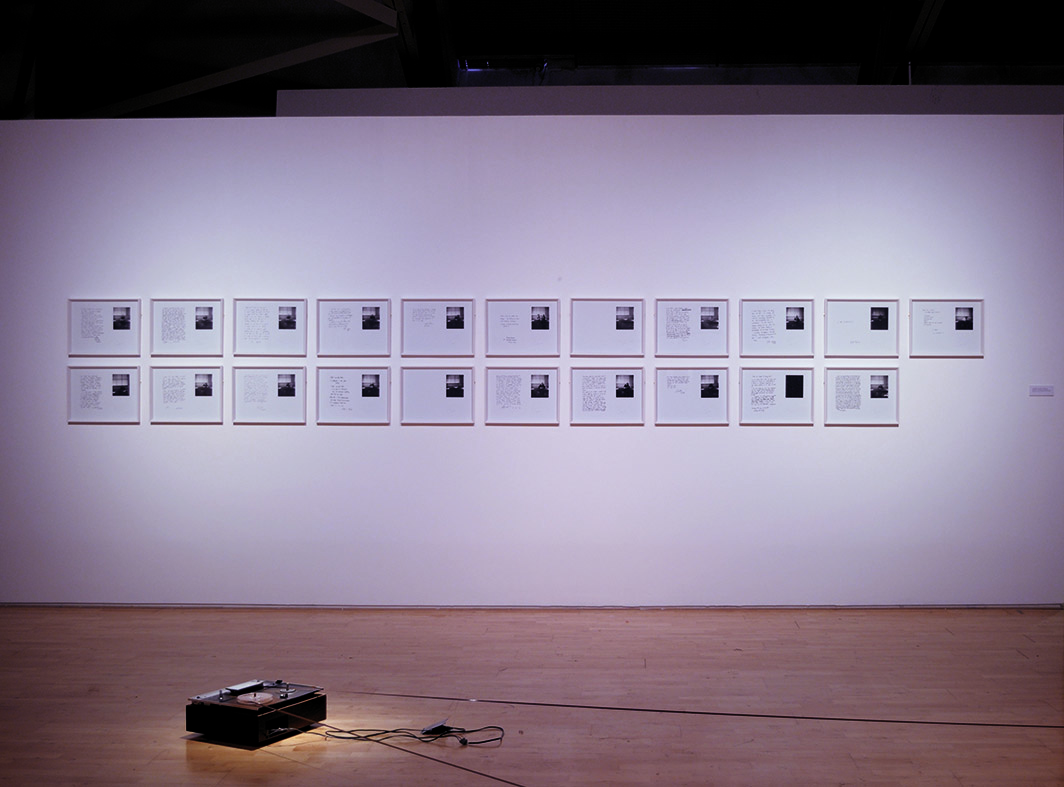
Peter Richards, 21 Variations, 2014. Textual and pinhole photographic documentation recording the responses of individuals, invited by Kim McAleese, to a previously undisclosed question. Series of 21, 16 x 12 inch framed silver gelatin prints. Edition of 5.
Birth, therefore, as the principal and eternal question. Twenty-one personal variations and one much more profound variation in the artist himself. Although the practice of pinhole photography is characteristic of his production, Richards uses a black and white film here for the first time, rather than large Duratrans sheets that usually bring together the luminescent time of the actions in front of the aperture in the background of his camera obscura.
Duratrans are used in the wall series Balancing, (not dancing with) a pole, five minute performances in which the artist himself tries to remain still in front of his darkroom, holding a long pole in his hand, in various positions and counting to three hundred.
We find that same pole, not very still at all in the previous work, in the remains of a work whose performance genesis occurred during the opening, Action, suspension, tension, and (quite likely) self-destruction. The act of counting to measure time, on the other hand, can be found in the smaller room, in another work that holds traces (audio and video) of the second performance held during the opening, Preparation for and anticipation of.
Time is the cornerstone of every work on display. It is time that Richards, using some technologies from the origins of photography, doesn’t want to chase or stop, but represent through its duration. This is the reverse process to that of the pioneers of photography, who were intent on shortening exposure time more and more. If Eadweard Muybridge succeeded in stopping the various phases of a movement of an animal or human body, (letting the whole of humanity discover never-before-perceived movements and upsetting all of art history from the end of the 1800s onwards) Richards, instead, challenges man to remain still in an ‘uncomfortable’ condition and thus shows time itself, or, in 21 Variations and previous works, collapses the time of an action that has a personal duration on print, demonstrating almost how time is not at all linear.
Then there is past time, the personal time of the past that seems to cheat the present and curb our future. And it is here that the much-desired tabula rasa is achieved through the burning of a family home movie, projected on three vintage projectors (Bell & Howell 256ex) in the performance cited above, Action, suspension, tension, and (quite likely) self-destruction or, in Stopping the spots, through a distance necessary to select those frames of old family 8mm and super 8mm films containing the white holes of burns.
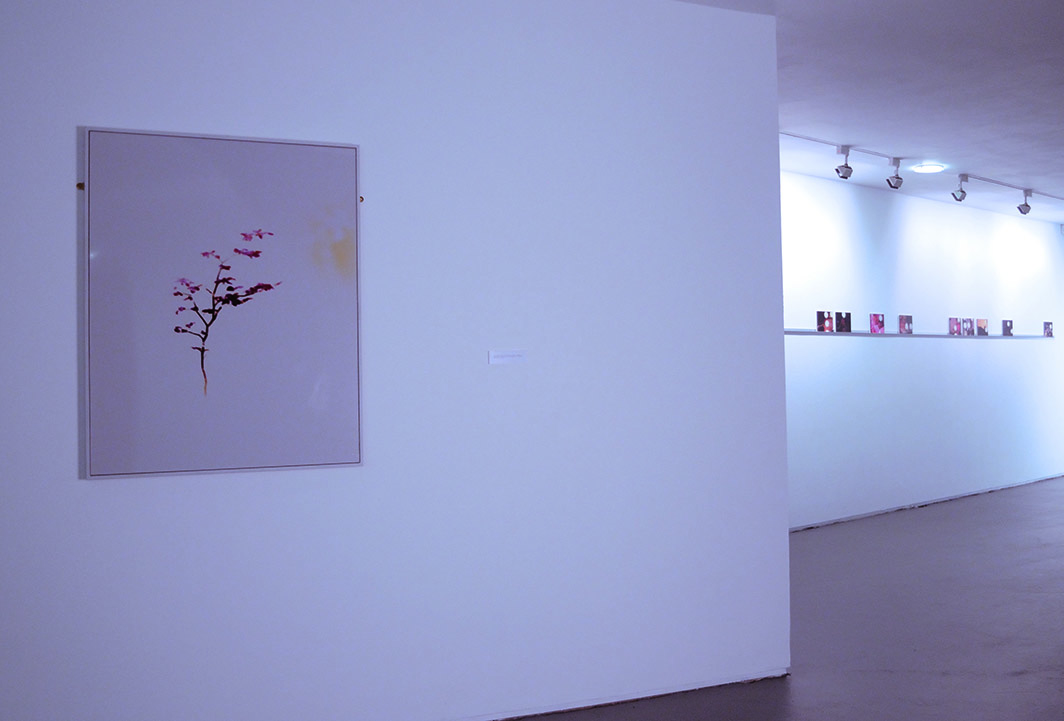
Peter Richards, The Significance of Vitalism in Red, 2013, pinhole exposed Duratran mounted on Dibond with laminate, 100 x 80 cm.
The family brings us back to the series that Richards created a few years ago on trees, represented in this location by The Significance of Vitalism in Red: probably the only true guide that cautions us about the various possibilities to follow, all of them valid. Branches from the same trunk, from the same roots.
Among these roots there is a fundamental one, which is found in the books left by Richards for the viewers’ use: the 1997 edition of Lucy Lippard’s book Six Years: The dematerialization of the art object from 1966 to 1972:…, published for the first time in 1973. The long title, white on a red background, already summarizes what Lippard herself writes in Preface: “The form of the book intentionally reflects chaos rather then imposing order.” And, a bit further ahead: “Fragmentation is more like direct communication than the traditionally unified approach (…) In any case, I enjoy the prospect of forcing the reader to make up his or her own mind when confronted with such a curious mass of information” [2].
Exactly like Lippard, Peter Richards constructs this show using his own past, both personal and professional, the contributions of people dear to him or colleagues, words and sentences taken from texts from his own formative library. He thus creates a citationist and temporal gear of multiple interpretations, creating an immersion into an apparent chaos where the main subject is time and the way of immersion is individual experience, capable of taking the more appropriate trajectory.
Richards uses the technology of the past because he is completely aware that “the current moment is in the grip of a ‘formal’ nostalgia”, to use the words of Mark Fisher [3], who further claims: “The artists that came to be labeled hauntological were suffused with an overwhelming melancholy; and they were preoccupied with the way in which technology materialised memory (…) What’s at stake in 21st century hauntology is not the disappearance of a particular object. What has vanished is a tendency, a virtual trajectory” [4].
Like many contemporary artists of the recent generation, Richards cites the past ‘formally’, but is interested in the various linguistic ways of transmitting content. In doing so he reveals himself absolutely as a child of a generation that experienced the great social and economic change of the end of the 1970s and beginning of the 1980s in the flesh, but, unlike the younger generation, is still chronically melancholy, in the political meaning defined by Fisher.
Inside his camera obscura he measures time. Inside his studio he observes the different variants of light that come through the blinds of the large windows that separate him from the world (subject of the work on display Tergo fenestram – blind), a filter between the darkness of creation and the light of the exposition that sees and foresees occurrences, in the hope that his perseverance and seriousness are heard, like that of Jeff in Rear Window [5].
